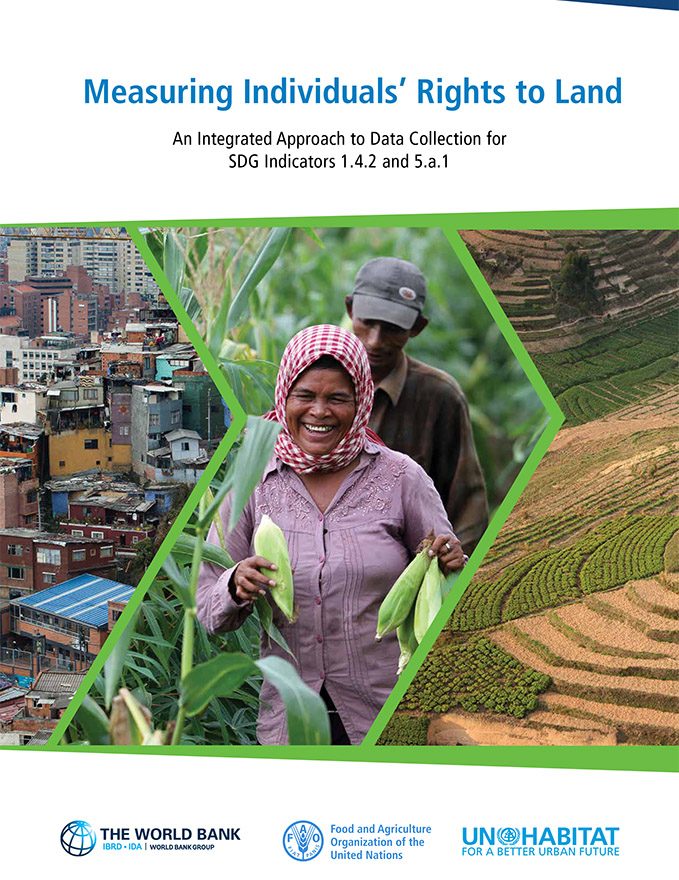The World Bank is a vital source of financial and technical assistance to developing countries around the world. We are not a bank in the ordinary sense but a unique partnership to reduce poverty and support development. The World Bank Group has two ambitious goals: End extreme poverty within a generation and boost shared prosperity.
- To end extreme poverty, the Bank's goal is to decrease the percentage of people living on less than $1.25 a day to no more than 3% by 2030.
- To promote shared prosperity, the goal is to promote income growth of the bottom 40% of the population in each country.
The World Bank Group comprises five institutions managed by their member countries.
The World Bank Group and Land: Working to protect the rights of existing land users and to help secure benefits for smallholder farmers
The World Bank (IBRD and IDA) interacts primarily with governments to increase agricultural productivity, strengthen land tenure policies and improve land governance. More than 90% of the World Bank’s agriculture portfolio focuses on the productivity and access to markets by small holder farmers. Ten percent of our projects focus on the governance of land tenure.
Similarly, investments by the International Finance Corporation (IFC), the World Bank Group’s private sector arm, including those in larger scale enterprises, overwhelmingly support smallholder farmers through improved access to finance, inputs and markets, and as direct suppliers. IFC invests in environmentally and socially sustainable private enterprises in all parts of the value chain (inputs such as irrigation and fertilizers, primary production, processing, transport and storage, traders, and risk management facilities including weather/crop insurance, warehouse financing, etc
For more information, visit the World Bank Group and land and food security (https://www.worldbank.org/en/topic/agriculture/brief/land-and-food-security1
Resources
Displaying 31 - 35 of 4907Unlocking Ethiopia's Urban Land and Housing Markets
Ethiopia’s rapidly growing urban centers are facing an unprecedented level of demand for urban land
and housing. How can Ethiopia supply urban land in an efficient and equitable fashion to accommodate
growing demand from industries and individuals for diverse uses? How can existing residents and
incoming migrants afford adequate shelter to survive and thrive in fast growing cities? The Ethiopia
Urban Land Supply and Affordable Housing Study aims to provide practical solutions to these
questions.
Unlocking Ethiopia's Urban Land and Housing Markets
Ethiopia’s rapidly growing urban centers are facing an unprecedented level of demand for urban land
and housing. How can Ethiopia supply urban land in an efficient and equitable fashion to accommodate
growing demand from industries and individuals for diverse uses? How can existing residents and
incoming migrants afford adequate shelter to survive and thrive in fast growing cities? The Ethiopia
Urban Land Supply and Affordable Housing Study aims to provide practical solutions to these
questions.
Unlocking Ethiopia's Urban Land and Housing Markets
Ethiopia’s rapidly growing urban centers are facing an unprecedented level of demand for urban land
and housing. How can Ethiopia supply urban land in an efficient and equitable fashion to accommodate
growing demand from industries and individuals for diverse uses? How can existing residents and
incoming migrants afford adequate shelter to survive and thrive in fast growing cities? The Ethiopia
Urban Land Supply and Affordable Housing Study aims to provide practical solutions to these
questions.
Measuring Individuals’ Rights to Land; An Integrated Approach to Data Collection for SDG Indicators 1.4.2 and 5.a.1
Land is a key economic resource inextricably linked to access to, use of and control over other economic and productive resources. Recognition of this, and the increasing stress on land from the world’s growing population and changing climate, has driven demand for strengthening tenure security for all. This has created the need for a core set of land indicators that have national application and global comparability, which culminated in the inclusion of indicators 1.4.2 and 5.a.1 in the Sustainable Development Goals (SDGs) agenda.
MYANMAR COUNTRY ENVIRONMENTAL ANALYSIS
ASSESSING THE OPPORTUNITIES FOR SCALING UP COMMUNITY FORESTRY AND COMMUNITY
FORESTRY ENTERPRISES IN MYANMAR
This report was prepared by a World Bank team led by Martin Fodor and Stephen Ling. The team was composed of Aye Marlar Win, Aung Kyaw Naing, David Gritten, Kyaw Htun, Lesya Verheijen, Lwin Lwin Aung, Martin Greijmans, Nina Doetinchem, Robert Oberndorf, Ronnakorn Triraganon, Thiri Aung, and Werner Kornexl.







